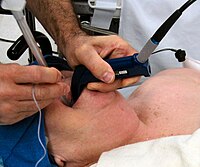
Photo from wikipedia
OBJECTIVE Paramedics may perform endotracheal intubation (ETI) while treating patients with out-of-hospital cardiac arrest (OHCA). The gum elastic Bougie (Bougie) is an intubation adjunct that may optimize intubation success. There… Click to show full abstract
OBJECTIVE Paramedics may perform endotracheal intubation (ETI) while treating patients with out-of-hospital cardiac arrest (OHCA). The gum elastic Bougie (Bougie) is an intubation adjunct that may optimize intubation success. There are few reports of Bougie-assisted intubation in OHCA nor its association with outcomes. We compared intubation success rates and OHCA outcomes between Bougie-assisted and non-Bougie ETI in the out-of-hospital Pragmatic Airway Resuscitation Trial (PART). METHODS This was a secondary analysis of patients receiving ETI enrolled in the Pragmatic Airway Resuscitation Trial (PART), a multicenter clinical trial comparing intubation-first vs. laryngeal tube-first strategies of airway management in adult OHCA. The primary exposure was use of Bougie for ETI-assistance. The primary endpoint was first-pass ETI success. Secondary endpoints included overall ETI success, time to successful ETI, return of spontaneous circulation, 72-h survival, hospital survival and hospital survival with favorable neurologic status (modified Rankin Score ≤3). We analyzed the data using Generalized Estimating Equations and Cox Regression, adjusting for known confounders. RESULTS Of the 3,004 patients enrolled in PART, 1,227 received ETI, including 440 (35.9%) Bougie-assisted and 787 (64.1%) non-Bougie ETIs. First-pass ETI success did not differ between Bougie-assisted and non-Bougie ETI (53.1% vs. 42.8%; adjusted OR 1.12, 95% CI: 0.97 to 1.39). ETI overall success was slightly higher in the Bougie-assisted group (56.2% vs. 49.1%; adjusted OR 1.19, 95% CI: 1.01 to 1.32). Time to endotracheal tube placement or abandonment was longer for Bougie-assisted than non-Bougie ETI (median 13 vs. 11 min; adjusted HR 0.63, 95% CI: 0.45 to 0.90). While survival to hospital discharge was lower for Bougie-assisted than non-Bougie ETI (3.6% vs. 7.5%; adjusted OR 0.94, 95% CI: 0.92 to 0.96), there were no differences in ROSC, 72 -h survival or hospital survival or hospital survival with favorable neurologic status. CONCLUSION While exhibiting slightly higher ETI overall success rates, Bougie-assisted ETI entailed longer airway placement times and potentially lower survival. The role of the Bougie assistance in ETI of OHCA remains unclear.
Journal Title: Resuscitation
Year Published: 2020
Link to full text (if available)
Share on Social Media: Sign Up to like & get
recommendations!